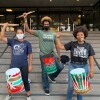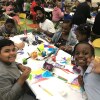How Artist-Parents Are Nurturing Culture – and What We Can Learn From Them

"How to Change" is a limited series for "Southland Sessions" exploring the most critical issues facing Southern California culture makers in this pivotal historical moment. Each column will explore a question posed to a range of artists and culture workers, and include recommendations to address these concerns from a practical, action-oriented perspective.
For the eighth and final installment of "How to Change," I asked, "How can we better support families and build a creative future by learning from artists?" This is a two-part article. Read part 1, "How are artist-parents adapting to the pandemic?" here.
Successful parenting requires the ability to adapt to unexpected circumstances, in the best of times. Over the past year in quarantine, the unexpected is happening daily. Parents have been struggling throughout the pandemic as economic insecurity, eroding work-life balance, children's needs at home 24/7 and online schooling have added to the burdens they already face in a culture that privileges individual earners over those who reproduce, physically or socially. Artists, already experienced at adapting to scarcity and change, apply this knowledge to their everyday lives and the way they raise their children.

Choreographer Heyward Bracey is raising a preteen daughter in a two-household setup. For him, understanding his heritage through Butoh dance "transformed my relationship with my history in my relationship with my daughter, and my relationship with my practice." Bracey views his artistic work as "a kind of activism," bringing self-knowledge to collaborators and audiences by tapping into shared ancestral lineages that the dominant culture often ignores. Connecting with Indigenous North American and African traditions through his artistic research gave Bracey "something to share with my daughter that I didn't have before." The dance community of which Bracey is a part frequently attends protests on behalf of racial solidarity and abolition movements. Bracey is keen to make his daughter aware of the relationship between her father's creative practice, her extended community of elders and the movement for social change.
Bracey's outlook reflects a personal journey. Before he became a parent, "in a way, maybe part of me hid from what was ahead," he admits. At the time, Bracey's support network of family was "heavily parochialized, that kind of trauma that's done to a lot of African American families that a lot of people are still trying to heal and work through." The intervening years have been a process of gathering a new community more aligned with Bracey's values. "Only recently do I feel like I've been able to shake off the illusion of American individualism," he reveals, "and feel like I'm more connected to and responsible for my actual lineage and my community and my arts practice." In the wake of the pandemic, many people are seeking such connections to offset the prolonged isolation.
Bracey's international approach to culture extends to his views on parenting. When his daughter was an infant, he and his former partner used the RIE parenting method that advocates for children to be supported and cared for while parents allow them to explore their world and take the lead whenever possible. "If I understand it correctly, [RIE] had to do with folks from the West, observing how bonds were formed between parents and children in other societies," Bracey explains. At times, following these practices meant sacrificing opportunities for professional or personal time to prioritize the child. Bracey contrasts this with West African culture's more balanced approach, which he preferred. In this approach, adults don't necessarily sacrifice their needs for those of the child at all times. "Our emphasis on our ancestors, those practices and how they extend to our children, it began to create a different sense of the purpose of the relationship" between parent and child. In the African tradition, "our children are also our ancestors," in the sense that responsibility is borne for both the past and the future generations. This integrated sense of history and connection to legacy informs Bracey's relationship with his daughter and his community beyond the daily routines of caregiving that often absorb a parent's focus.
For social practice artist and curator Irina Contreras, the image of an artist-parent was shaped by people she encountered in her academic career. Says Contreras, "For me, it was really important to see people living their lives and being themselves." Contreras describes her undergraduate professor at Otis, Meg Cranston, "doing her very Meg thing like giving us lectures on [experimental music ensemble] Throbbing Gristle and then lo and behold, here comes a toddler." Cranston's son, then five or six, is now an adult. Professors and mentors who model that balance provide young people with a valuable education beyond the curriculum. Working with artist Juba Kalamka was another lesson. "I remember producing a show that Juba was in and we planned to do some stuff and then he unexpectedly showed up on my doorstep with his four-year-old," Contreras recalls. "He just seemed so happy and positive, openly struggling, of course, but really in love with what he was doing, his family, so much joy and appreciation for them," demonstrating an acceptance and presentness that Contreras strives to achieve with their own child.

Choreographer Daniel Phoenix Singh has a vision for a more sustainable culture for working parents. "I am always intrigued by co-op models, where everyone has a part of the solution," he explains. He imagines a collective approach to caregiving that resembles the "pandemic pods" some parents created with paid teachers during the pandemic. Says Singh, "I would love to give up one day of work a week, if I were part of a group of parents that took care of their kids and taught them while they needed that, before they could go to school." He considers this a socially reproductive investment of time: "We're all invested in the kids and then we're working alongside the caregivers, we understand the difficulty and the time consumption, and pay them equally." Singh currently has to rely on the au pair system that places international students in low-paid caregiving roles without qualifications or protections, because his income as a single parent cannot cover the costs of a nanny or daycare for his twin toddlers. He envisions that the au pair system could be updated: "A higher salary, make the au pair go take university classes, not just learn English by osmosis." He maintains that the benefits of the program should extend beyond American parents to the international students who participate in the program, as they would also be better served by a paid position that supports their financial independence.
Singh describes how parenting has "potentially given me more options in choreography, to keep exploring a good idea with good intention and trust that the process is going to unfold something that's worthwhile and worth keeping." Prior to raising twin toddlers in a pandemic, he might have sought to maintain a tighter sense of control with his company that could inhibit new ideas from peeking through. "I'd often push my dancers to get to a place faster, I had a vision and I couldn't quite get it out in words, but I'd want them to be there already." He anticipates a more organic and fluid approach to collaboration when he returns to directing a company down the line.

Painter and mixed media artist Monika Ramirez Wee reflects on how becoming a parent has made them a better artist. Prior to becoming a parent, "I thought it would take up a lot of time, and I feared how it would impact my art making ability," they recount, "and it did, that's just the reality." The conflict of making time for professional and creative work while being primary caregiver to others is inescapable, whether one is a parent or not. "What I didn't know, what happened, is that I improved my art, because what being a parent has done for me is it made me incredibly present in my life," Ramirez Wee explains. They applied these insights to their professional work: "My thesis was about parenting as a mindfulness practice, because what else are you going to do but chop wood, carry water, change diapers, clean out sippy cups, so I better make the best of this." Artist ancestors like Ruth Asawa, who raised six children while transforming the San Francisco public school system and the field of sculpture, play an important role in shaping Ramirez Wee's world view.

Coming out as queer also helped Ramirez Wee become a more authentic person and parent. Rethinking their entire identity and lifestyle helped Ramirez Wee to embrace their mistakes and approach their children with greater honesty. "You're going to say, I'm sorry, I didn't do that right, and why don't we talk about it and let's figure out how to do it again," they explain, which is a contrast to the hierarchical family structure in which they were raised. "I feel really strongly about that as an educator also," they continue. "A good educator is somebody who says that project doesn't work out so well that way, I think it needs to be modified," helping the student to find a solution that works for them without imposing the instructor's own way of doing things at their expense. Iterating to figure out "how to do it better" is a life lesson in work and in art.
For Ramirez Wee, role models included artist Sharon Siskin, a graduate school mentor at now-defunct John F. Kennedy University, whose body of work includes an extended meditation on "Family" in addition to reflections on her Jewish heritage, the HIV/AIDS crisis, ecology and public space. "During my thesis defense, I had an advisor who wanted me to take out a huge portion about being a parent," Ramirez Wee remembers. Siskin backed up Ramirez Wee's position by citing parent-artists such as Mary Kelly whom they had established as contextual to their own work.

With the pandemic drawing to a cautious end, there are small insights that we can take with us as we re-emerge. Says Heyward Bracey, "During the pandemic we had to learn to rely on each other in ways that otherwise we might have neglected or it might have taken longer or some things might have remained kind of theoretical." There's a renewed focus on mutual aid in Los Angeles with artist-led efforts from Crenshaw Dairy Mart, The Underground Museum, Auntie Sewing Squad and Summaeverythang. "I'm farming again," says Ramirez Wee, for the first time in decades. "I've got this amazing garden and with commuting from home to campus that would not have been possible." They describe how "it's often the tender moments" that the family can capture before their oldest child goes away to college in the fall. Family reading sessions where the four of them read a book together and discuss it has become a cherished tradition, "a common experience that wasn't around a TV." Patience is a skill that all of the artists are developing. Says Singh, "I think kids take that to a whole new level, they learn all your weak points very quickly, even before they can speak and they push, push, push, push on it" until you either break or learn to cope. The work is improved by these lessons as much as the family experience.








